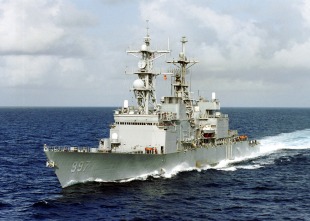Эсминец USS Hayler (DD-997)
Основная информация
Главные размерения
Машина
- 4 * General Electric LM2500 gas turbines
- 2 * shafts, 80,000 shp (60 MW)
Персонал
Боевые силы и средства
- AN/SPS-40 air search radar
- AN/SPG-60 fire control radar
- AN/SPS-55 surface search radar
- AN/SPQ-9 gun fire control radar
- Mark 23 TAS automatic detection and tracking radar
- AN/SPS-65 Missile fire control radar
- AN/SQS-53 bow mounted Active sonar
- AN/SQR-19 TACTAS towed array Passive sonar
- Naval Tactical Data System
- AN/SLQ-32 Electronic Warfare System
- AN/SLQ-25 Nixie Torpedo Countermeasures
- Mark 36 SRBOC Decoy Launching System
- AN/SLQ-49 Inflatable Decoys
- 2 * 5 in (127 mm) 54 calibre Mark 45 dual purpose guns
- 2 * 20 mm Phalanx CIWS Mark 15 guns
- 1 * 8 cell ASROC launcher (removed)
- 1 * 8 cell NATO Sea Sparrow Mark 29 missile launcher
- 2 * quadruple Harpoon missile canisters
- 2 * Mark 32 triple 12.75 in (324 mm) torpedo tubes (Mk 46 torpedoes)
- 1 * 61 cell Mk 41 VLS launcher for Tomahawk missiles
- 2 * Sikorsky SH-60 Seahawk LAMPS III helicopters
The USS Hayler (DD-997) was a Spruance-class destroyer serving in the United States Navy from 1983 to 2003. Named after Vice Admiral Robert W. Hayler (1891–1980), it marked the concluding ship of its class.
In the fiscal year 1978, Congress greenlit the production of two extra Spruance-class destroyers, yet only one received funding. These were envisioned as helicopter destroyers (DDH), designed not to exceed the cost of a standard Spruance-class. Litton-Ingalls developed a preliminary design for DDH-997, altering the helicopter deck's placement aft, elongating the hangar's length, and relocating the Sea Sparrow launcher atop the hangar. The design could house two SH-3 Sea Kings or four smaller SH-60 Seahawk or SH-2 Seasprite helicopters. Although constructing the prospective DDH-997 wouldn't have significantly surpassed the expenses of a standard Spruance-class, the exhaustive detail design and engineering work beforehand would have been substantial (similar to the Kidd-class, costing $110.8 million). This notably inflated the DDH's cost above that of a typical Spruance-class destroyer. While the additional cost might have been reasonable for a series-produced DDH, it was hard to justify for a single vessel. Consequently, the Navy opted to build Hayler using a design akin to the rest of the class but integrating select systems from the Ticonderoga Cruiser and Kidd Destroyer blueprints.
Hayler's construction commenced on 20 October 1980 at Ingalls Shipbuilding in Pascagoula, Miss. It was launched on 2 March 1982 and commissioned on 5 March 1983.
According to the U.S. Navy, Hayler's emblem embodies Vice Admiral Hayler's influential leadership, commitment to his nation, naval expertise, and the esteemed history and customs of the naval service. The gold stars on a blue background in the upper shield signify Admiral Hayler's involvement in various Pacific Island Campaigns during World War II and the numerous awards he earned, some multiple times. The chevron symbolizes strength and support, while the blue crosses represent the Admiral's three Navy Crosses, a recognition of valor second only to the Medal of Honor. The crossed red battle axes epitomize strength and resourcefulness under duress, reflecting Admiral Hayler's wartime service. The stars on the axes recognize the Silver and Bronze Stars awarded to the Admiral for bravery. The bomb symbolizes naval firepower, gunfire support, and anti-aircraft fire, signifying Admiral Hayler's contributions to naval ordnance during World War II. The anchor signifies the fleet and Admiral Hayler's endeavors to fortify and safeguard it. The dominant colors—red, white, and blue—mirror the national flag, representing Admiral Hayler's patriotism and allegiance to the flag and the nation it represents.
The ship's motto, «Courageous in Conflict,» epitomizes the resolute professionalism and unwavering leadership evident in Vice Admiral Hayler's career, now guiding HAYLER sailors.
On 23 October 1988, Hayler collided with the West German replenishment tanker Rhön, sustaining severe damage aft. It underwent repairs at Rosyth Dockyard, Scotland, until 20 November.
Assigned as an escort for the USS La Moure County (LST-1194), Hayler was involved in the accidental grounding of the vessel near Caleta Cifuncho Bay, Chile, during routine amphibious training on 12 September 2000.
Hayler was decommissioned on 25 August 2003 at Norfolk Naval Shipyard, Portsmouth, Va. It was removed from the Naval Vessel Register on 6 April 2004 and sunk during the 2004 Sink Exercise on 13 November 2004.
- Комментарии
 ru
ru en
en uk
uk





 Военно-Морские Силы США
Военно-Морские Силы США Ingalls Shipbuilding
Ingalls Shipbuilding